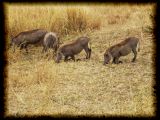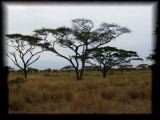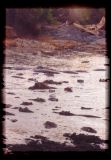They sailed in from Madagascar, writes Thomas Pakenham, Irish, “extreme” tree lover and writer of “The Remarkable Baobab.” Imagine giant dhows full of giant baobabs making the voyage from Madagascar to the shores of East Africa! What really happened is more prosaic, but no less wondrous. It was the giant seedpods of the baobabs that bobbed over from the island to the mainland. And now baobabs can be found in most African countries.
The largest know baobab, which is in South Africa, has a 100 feet girth. (The only other tree with that kind of girth is the Indian Banyan.) No wonder the tree, worshipped and mythologized, is known sometimes as the wooden elephant. The most ancient ones are around 1000 years old.
For those who have never seen a baobab, and may be wondering what I am babbling about click on the images by the side to see them in their full splendour!
So now you have seen the giants. Are you at all impressed? We see smaller, newer baobabs even in Dar es Salaam. But to see baobab groves: rows of chunky trees, their leafless, spreading, root-like branches, framed against a balmy, blue sky, their thick trunks firmly rooted in red-brown earth, is to experience a special delight. At least for a die-hard baobab fan like me. Imagine my happiness then in Tarangire National Park — home to humungous baobabs and huge elephants.
Even before we entered the park, another giant –the ostrich– regarded us from a safe distance. Native to the African savannah, this bird with a permanently curious expression, reputed to be bad-tempered, is now bred all over the world, including in freezing Northern Europe, where it manages to survive. Brrrr!
It is the largest and heaviest bird. Ergo it lays the largest egg. Is it a bird at all, since it can’t fly? Well, yes, apparently it is a bird and makes up for not flying by running, very fast (70 kmph).
The gay giraffes
Interestingly, Tarangire is not named after the baobab or the elephant, but a strange creation of nature – the warthog (ngiri). Tarangire means river of warthog. When I first saw a picture of a warthog, I thought it looked like a grotesque creation of biotechnology! A cross between a hog and a goblin, that’s how Marc-Antoine described it! But as in the case of hyenas, as we saw more and more warthogs, familiarity bred acceptance. Warthogs are shy and can turn tail and run when they see the curious metallic beast, that is the safari jeep, approaching.
Their most amazing trait is their ability to live without water for several months, if need be. It is thought that they do this because they can tolerate higher than normal body heat and hence conserve water, which other animals use up for cooling. (I.e. they don’t sweat.)
We saw groups of tembo (elephants) and giraffes grazing on trees, including very thorny acacia, in Tarangire and later in Serengeti. Many species of acacia, rise straight and tall, with their shapely, umbrella-like canopies, above the swatches of rusty-gold grass, in the endless plains of Serengeti. They look slim and elegant, particularly when contrasted with baobabs: beauty and the beast.
Among all the land animals, giraffes seem the most bold and curious. They stand and stare as we stand and stare at them! There is direct eye contact and possibly some communication. The elephants largely ignore humans, and go about their business, eating, drinking or bathing, their flapping ears and swishing tails, among their more endearing features. Baby elus of course turn me into a ball of adoring mush!
Did you know that giraffes have an active gay culture? We saw male giraffes “necking” or neck fighting, using a circular motion, in Manyara National Park. One reason is the usual establishment of superiority through a display of male prowess. Males more successful at “necking” are said to have greater access to females. The other reason is sexual. Males frequently mount each other and climax. The other interesting thing about them is that they need less sleep than any other mammals – between 10 minutes and 2 hours in a 24-hour period. And they are strong; a single well-placed kick can shatter a lion’s skull or spine.
We saw many birds during our safari, particularly on the banks of the small, winding rivers and streams, or lakes, saline or fresh water. There were the classic, ominous profiles of vultures, silent on tree tops; eagles and hawks in flight and at rest, the beautiful grey heron that I know from Canada, colonies of pelicans and flamingos (oouu, what beauty!) on saline lake shores, birds almost as large as ostriches – the Kori bustard and the Secretary bird, gaily coloured Superb Starlings, common as the crow, at our campsites and in parking lots, and many more.
Boot camp-ing
After our round in Tarangire National Park, we drove to a beautiful green campsite, our first, appropriately named Paradise. It was set among a grove of palms and had a tap with a sink and running water. This was supreme luxury. Alas, worse was to follow and our camping life soon lost its charm.
We had seven straight nights in small tents, with my 72-year-old mother on her first (and last) camping trip ever! The crowded, badly maintained public campsites brought stinking pit toilets, broken showers and inconveniently placed, leaking water taps. My mother rose heroically to the occasion and was held up as an example by the tour guides.
A positive feature of camp life was the simple, yet absolutely delicious food that Ema (Emmanuel), our cook, managed to concoct for us in the communal, dimly lit and very sparsely out-fitted camp kitchens. He is hoping to get a driving license and become a driver-guide, like our impressively knowledgeable and well-organized guide Good Luck. Very much a modern Tanzanian, Good Luck spoke up for love marriage on one afternoon drive to a 18th century, former agricultural settlement called Engaruka. This reminded me of a favourite debating topic in Indian schools and colleges – love versus arranged marriage!
If travel is about pushing buttons and extending boundaries, camping certainly did that for me! The ordeals were worth braving, for each day brought such incredible delights.
Animals – strange and familiar
For example, in Serengeti, perched on top of impressive rock outcrops, known as kopjes, were diminutive rock hyraxes. One would expect them to be related to rats, but in fact, they are long-ago relatives of the mighty elephant, through a remote common ancestor – the sea cows or dugongs and manatees! (Google them; they are worth looking at – strange creatures indeed!) Fossil remains suggest that rock hyraxes were as big as oxen once! Evolution plays interesting games.
I will never forget the 30 odd hippos, in a large, stinky, muddy, algae infested, pond-lake in the Serengeti – looking inflated, pinkish, rubbery and awe inspiring. Their giant heads and snouts, stuck out above the water. A couple were positively horny and mounted the females, though it was hard to know if there was any tangible outcome from these under-water moves!
Like the pretty antelopes, called the impala, hippos have harems. They can kill crocodiles and lions. Because their territory is encroached, more and more, by humans — farmers and tourists — they kill more humans than any other animal in Africa. They come out of the water every night to feed on 50 kg of vegetation! They are perfectly at home in water – baby hippos are born under water. They have to resurface to breathe every 3-5 minutes (young hippos more frequently) and do so automatically, so they can sleep underwater.
And we saw monkeys, so like us, with their squatting postures, “developed” hands and a range of facial expressions. Always very watchable. We saw vervet monkeys; one, secretive blue monkey and colonies of baboons. Good Luck told us that five baboons sit at the tops of trees, on a lookout, every night. There is a rota system, with a changing of the guard at some point in the night. How clever! A fierce fighter, adaptable, capable of living in varied habitats, very social and communicative, this is not an endangered species!
Kudos for the Blue Planet
The safari was the highpoint of my travel in Tanzania. If countries were rated on the basis of their wealth in flora and fauna, and not GDP, than what would be the rank for Tanzania?
As I finish writing this, I have been reading about the Stern report on climate change and Tony Blair’s appeal to act now (however selfish and politically motivated, it is still a sound one) to invest in saving the planet now or regret deeply later. Possibly forever. The latest UN meeting on the environment is taking place in Kenya right now.
I am so very glad and thankful that I got to admire all these animals and live these stunning vistas. Even as it expanded my admiration for Mother Nature, the safari also highlighted, by contrast, the tremendous achievements of human culture, particularly for me, the poetry of the arts, architecture, human languages and communication, cuisine, costume and environmentally conscious science.
The journey renewed my desire to live more sustainably, and revitalized my prayers for the survival of the Blue Planet, ideally with a sensitive human presence. May the animals, birds, trees and all the living creatures of East Africa survive and thrive for aeons to come!

















